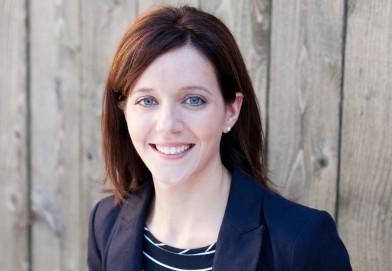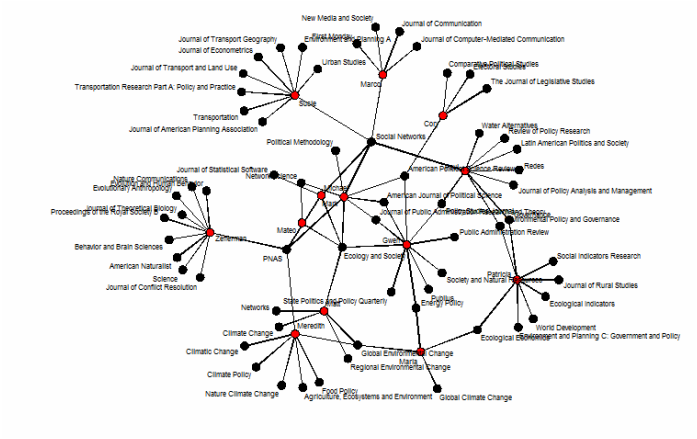Watch Balazs Vedres entire Speaker Series talk “Escaping Network Gravity” below or on SONIC’s YouTube channel.
Watch Balazs Vedres entire Speaker Series talk “Escaping Network Gravity” below or on SONIC’s YouTube channel.
 Each summer, the editorial board of Communication Methods and Measures, the official journal for the Communication Theory and Methodology Division of the Association for Education in Journalism and Mass Communication (AEJMC), nominates what they consider to be the three best articles published in the prior year. The executive board of CTM then chooses the winner of the Article of the Year Award from those three.
Each summer, the editorial board of Communication Methods and Measures, the official journal for the Communication Theory and Methodology Division of the Association for Education in Journalism and Mass Communication (AEJMC), nominates what they consider to be the three best articles published in the prior year. The executive board of CTM then chooses the winner of the Article of the Year Award from those three.
We are proud to announce that former SONIC graduate student, Brooke Foucault-Welles received the Article of the Year Award for her paper “Dynamic Models of Communication in an Online Friendship Network,” coauthored by Tony Vashevko, Nick Bennett and Noshir Contractor. Bennett was previously a SONIC research technologist and Vashevko was a SONIC research associate. This prestigious award will be presented at the AEJMC Annual Conference in San Francisco, California.
Click here for more information about the conference.
Click here to read the winning article.
Read about Prasad Balkundi’s talk from May 7th, 2015 and watch the full presentation below on SONIC’s YouTube Channel.
Eric Forbush was featured in the McCormick School of Engineering’s news for his work using NetLogo to model how astronauts on the mission to Mars would switch tasks mid-mission.
Read more about Eric’s work here.

At the 2nd International Conference on Internet Science in Brussels, Belgium on May 28th, Noshir Contractor delivered a speech titled “Leveraging WINS (Web/Internet/Network Science) to Address Societal Challenges”. Noshir was a keynote speaker along with Marietje Schaake, Christian de Larrinaga, Andrea M. Matwyshyn, Marcelo Thompson, and Motohiro Tsuchiya.
Learn more about the 2nd International Conference on Internet Science
The International Communication Association inducted Professor Noshir Contractor as a Fellow at the annual ICA conference held in San Juan, Puerto Rico on May 21-25, 2015. The inducting committee had the following to say about Prof Contractor:
“Noshir Contractor is recognized for his stellar work on communication networks and organizational communication, and for his path-breaking research in computational social science, communication information systems, and multi-level network modeling. His co-authored book Theories of Communication Networks is by far the most comprehensive and significant theoretical treatise on communication networks. He is one of the few scholars in our discipline to have published in the prestigious journal Science and in the coveted Proceedings of the National Academy of Sciences. He is the foremost scholar in multi-method, multi-level network modeling and has become a national and international leader in applying network analysis to broad-scale social problems. This intellectual leadership extends to policy arenas through his work on emergency response systems, science teams, sustainable development, cyberinfrastructure, and knowledge networks. He has produced a corpus of scholarship that has carved new terrains, captured the attention of researchers inside and outside the field, and garnered an outstanding record of external funding.”
Learn more about ICA Fellows
Michael Levy of the Center for Environmental Policy and Behavior at UC Davis created a bipartite network of using his coworkers and their preferred journals to illustrate the functional clusters within the highly interdisciplinary lab. He then converted the visualization into a single mode network using ggnet – a ggplot implementation (via the GGally package) and calculated degree, betweenness, and eigenvector centrality for each journal for a more detailed picture of the overlapping interests within his community. He provides his r code for anyone who wants to apply try the excersize with their own lab.
Check out Michael Levy’s blog to read more and play with his code : http://environmentalpolicy.ucdavis.edu/blog/2015/03/386


At the ARS 2015 in Anacapri, Italy on April 29th, Noshir Contractor was the keynote speaker for the Large Networks and Big Data Workshop. His speech was titled “Leveraging Network Science to Address Great Societal Challenges”. Topics included how network science is the solution to making sense of big data and monitoring and anticipating global problems to design effective solutions.
Learn more about ARS 2015 or Noshir’s speech
Multitaskers receive a lot of praise for being able to do many things at once, but a study conducted at Stanford University shows that multitaskers are significantly more prone to distractions, making it difficult for them to accomplish tasks in a timely manner. Moreover, there is a lingering effect to multitasking in which individuals can’t shut off their multitasking tendencies when not multitasking.
In reality, only a very small number of the population can efficiently multitask. These “supertaskers” represent less than 3% of the population according to a study done at the University of Utah.
Are you are multitasker? Take the following test to find out how you measure up against both low and high multitaskers.
Take the test here: http://www.nytimes.com/interactive/2010/06/07/technology/20100607-task-switching-demo.html?_r=0
Read more at: http://www.nytimes.com/2010/06/07/technology/07brain.html
 SONIC Lab is proud to welcome Prasad Balkundi, who will present a talk on Thursday, May 7th, 2015 at 2:00 PM in the SONIC Lab in the Frances Searle Building 1-459. All are welcome to attend. To schedule a one-on-one meeting with Professor Balkundi please schedule a time here. Please contact Nancy McLaughlin with any questions or comments.
SONIC Lab is proud to welcome Prasad Balkundi, who will present a talk on Thursday, May 7th, 2015 at 2:00 PM in the SONIC Lab in the Frances Searle Building 1-459. All are welcome to attend. To schedule a one-on-one meeting with Professor Balkundi please schedule a time here. Please contact Nancy McLaughlin with any questions or comments.
Culture, Boundaries and Attitudes: A Meta-Analytic Test of Tie-Strength Theory
Although the strength-of-weak-tie theory is foundational in social network research, studies have reported inconsistent results sometimes supporting the weak tie theory and other times contradicting it. To address these inconsistencies, we explicate three boundaries of weak-tie theory: culture, labor markets, and outcomes. First, the theory was developed and tested extensively in Western nations, raising the issue of whether cultural context affects outcomes. Second, the theory was tested using lower-level applicants finding jobs across organizations, raising the issue as to the applicability of the theory for job movement within organizations for high-ranking employees. Third, beyond the question of finding a job, the question arises as to strength-of-tie effects on a broader set of outcomes such as access to information and job attitudes. Based on a meta-analysis of 101 studies (n = 23,303) we found that strong ties were more potent than weak ties in conformist cultures. Second, strong ties within the organization were more beneficial than weak ties. Also, managers benefitted more from strong ties. Third, strong ties facilitated immediate effectiveness and positive job attitudes whereas weak ties enhanced distal effectiveness for low-end employees.
About Prasad Balkundi
Prasad Balkundi is an associate professor of management at the University at Buffalo, State University of New York. He received his PhD in business administration from Pennsylvania State University. His research interests include social networks and leadership in teams and his work has appeared in the Academy of Management Journal, Academy of Management Review, Journal of Applied Psychology and Leadership Quarterly.
[line]